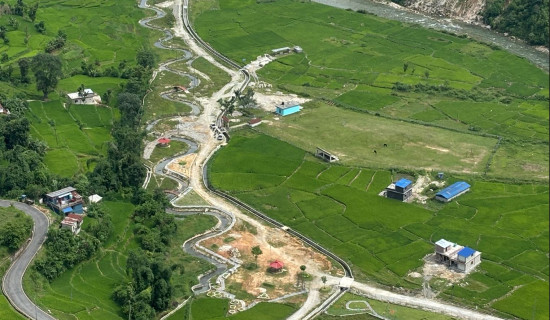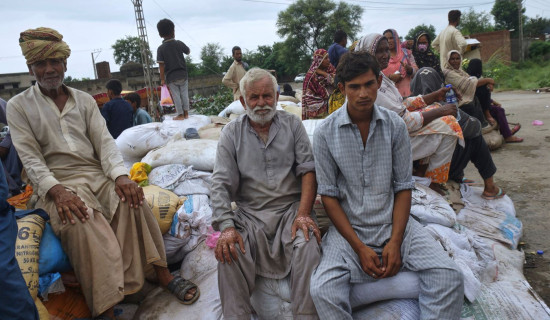- Tuesday, 2 September 2025
Modernise Land Management System
The focus of land management lies, inter alia, on sustainable land use, land tenure security and optimum utilisation of land for various purposes such as agriculture, housing and ecological conservation. To achieve these goals, it is imperative to systematise land use planning, land registration and GIS-based data management. In Nepal, issues relating to landlessness are emerging on an unprecedented scale. So, resolving such issues also falls under the purview of land management.
Land use planning is concerned with assessing and allocating land for various purposes such as agriculture, settlement, infrastructure development and environmental protection. The land tenure system focuses on clear, equitable tenure for public, community and private land to ensure land rights and avoid conflicts. Land management also includes registration of land and keeping land records systematically. Technology like GIS is helpful in mapping, data analysis, parcel identification, monitoring of land use changes and ecological conservation. Land management is closely linked to ecological conservation, sustainable agriculture, food security and natural resource conservation. All this contributes to effective land planning and management.
Legal mechanism
Nepal has a robust legal framework for managing land. The National Land Policy, 2012 and the Land Use Act, 2019, are there for this very purpose. The policy aims to secure land rights for women and landless individuals, promote sustainable housing, and ensure the optimal use of land. The act focuses on using land for various purposes such as agriculture, settlement and conservation of the environment. Administration and implementation of the land policy and act are looked after by the Ministry of Land Management, Cooperatives and Poverty Alleviation.
Despite the existence of the above legal mechanism, land management is not satisfactory. Agriculture is often carried out in an unsustainable way, leading to adverse conditions such as soil erosion, loss of edaphic fertility and depletion of nutrients. Further, making arable land fallow for years due to a lack of manpower is another factor that affects the fertility of land. This situation has arisen owing to migration from hilly areas to the Tarai and from rural to urban areas or foreign countries. Other issues relating to land management are fragmentation of land, encroachment upon public land, rapid urbanisation, ineffective land record systems and poor coordination among government entities looking after land management.
Migration of poor, landless people from rural areas to urban centres has produced a great strain on the urban areas. Such people tend to encroach upon government land, especially along river banks and in forested areas. Clearing forests for settlement has led to deforestation, resulting in land degradation, soil erosion, landslides and other adverse environmental conditions. Establishing settlements along rivers has posed a threat not only to the settlers themselves but also to the riparian system. Further, this has given rise to slum areas. Slum areas are usually unmanaged settlements with poor infrastructure and service delivery. They lack infrastructure, sanitation, hygiene and other facilities. They are a headache for city planners.
The issue of landless squatters has been a perennial problem for the government. The number of landless squatters is growing, particularly in the Kathmandu Valley. The policy of the government is partly to blame for this burgeoning problem. The government has announced the distribution of land to landless squatters in the Kathmandu Valley itself, irrespective of their home districts, provided they have occupied the present government land for ten or more years. This has encouraged landless squatters to illegally occupy government land.
The general public thinks that not all the landless squatters are genuine; they may be the cadres, relatives or favourites of political leaders. It has been found that some so-called landless squatters have rented out their huts built on government land illegally occupied by landless squatters. So it has been overdue to separate genuine landless squatters from the so-called ones. As the issue of landless squatters has turned complicated, the government must work around the problem and come up with a viable solution. The government should muster up the courage to identify fake landless squatters and take strong action against them. And genuine landless squatters should be provided with land in their own districts, not in the Kathmandu Valley. This will settle the issue of landless squatters to a great extent.
There is a complex land tenure system with multiple land ownership categories: private, government and guthi (religious trust). Accurate data on the land is lacking. Land ownership records are not systematic. Although the government is trying to digitise land ownership records, the progress on this front is sluggish. In order to improve land administration and management, the use of technology like GIS is crucial to enhancing accuracy, transparency and accessibility to easily retrieve required information on land.
Policy reform
Policy and legal reform are another area that should be improved to implement the legal provisions to streamline land management. Loopholes in the legal mechanism, if any, should be bridged so that no one can take advantage of such loopholes. There is also tenure insecurity among rural poor and indigenous communities. The government should take concrete measures to give justice to such vulnerable communities. Local governments can be made capable of managing land in their jurisdictions. But for this, they should be equipped with skilled manpower and resources.
One of the burning issues relating to land management is encroachment on public land. The government should take strong measures to curb such encroachment, which has been going on for years. The government should encourage sustainable practices in agriculture, forestry and settlement. Well-managed settlement, climate-resilient farming and agroforestry should be encouraged to prevent land degradation and promote ecological conservation. What is more, the government should pay heed to developing rural areas with a focus on agriculture. Agricultural development not only restores the quality of barren land but also contributes to rural industrial development, thus creating job opportunities for rural people and retaining them in rural areas.
(Maharjan has been regularly writing on contemporary issues for this daily since 2000.)
















